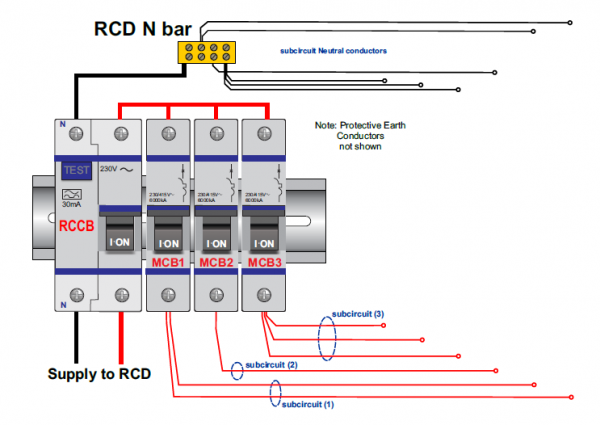Electron Issue 106
Keeping you up to date with the latest regulatory changes, exam reports, technical issues, consultation results and other issues affecting electrical workers - published February 2021.

Presiding Member's update

Happy New Year. With the new year underway, it is a good time for electrical workers to calibrate test equipment and to make sure systems and processes are fit for purpose. Take time to also ensure your standards are up to date. Remember that the standards you need are available via the Electrical Workers Registration Board portal.(external link)
COVID-19 will continue to create challenges over 2021. Supply chains are being impacted, and employers no longer have easy access to overseas workers. Government initiatives have, however, been created to help employers who take on trainees. Now may be a good time to evaluate your staffing needs and think about taking on an apprentice. For further information on the support available, go to the following pages Skills and Government help with recruitment.
The Board held its first post-lockdown Meet and Greet in November. It was good to re-engage with electrical workers, and the Board intends to return to a full Meet and Greet schedule this year. Meet and Greets are a great opportunity to learn about the Board’s functions and to be updated on Board activities and industry news. You can find this year’s schedule on the EWRB website. The Board will also be looking at opportunities to visit some of the regions not covered by the schedule. Invites for Meet and Greets are sent to electrical workers in the region the Board is in and reservations are on a first-come, first-served, basis so make sure you don’t delay in confirming your attendance when you receive the invite.
The coming year is also going to see changes to the Board’s system that manages electrical worker registration and licensing. The legacy system is being replaced with a new system, and communications will be sent to those electrical workers who will be relicensing in the near future to explain the differences.
Mel Orange
Presiding Member
Registrar update

Kia ora
Welcome to the 106th issue and first edition of the Electron newsletter for 2021.
I trust the majority of you had an opportunity to have a break relaxing with friends and whānau over the holiday season. For those of you who worked through, I hope you have a decent break planned in the coming months.
This issue of Electron includes detailed information on Competency Programme (CP) requirements. It reminds all electrical workers to be well prepared prior to attending a programme and to ensure they have access to suitable test equipment for the practical assessment element of the programme. I recommend if anyone is unsure or not familiar with what they need to have, or do, before attending a programme, to contact their programme provider.
One area the Board has identified in the course of its disciplinary hearings is a reliance on verbal assurances that work was tested and safe instead of relying on correctly completed Certificates of Compliance (COC) and Electrical Safety Certificates (ESC). These are essential legal documents that can be relied upon to provide an assurance that the work has been tested and is safe and compliant. It is also important to understand that COCs and ESCs have different functions and need to be correctly completed for those particular functions. I recommend you ensure you are providing the correct certification in the prescribed format. Practitioner guides and other resources can be used to assist you in confirming you are supplying correctly completed certifications – here are some useful links:
- EWRB Tool Box: What paperwork do I need to complete?
- WorkSafe: Electricity and Gas High-risk Database(external link)
- WorkSafe: Designing, maintaining safe installations(external link)
Finally, it certainly feels good to have 2020 behind us, and I wish you all a safe and prosperous 2021.
Duncan Connor
Registrar of Electrical Workers
Changes to the licence and registration, competency and safety requirement processes
You are one of approximately 30,000 electrical workers who renew your practising licence every two years. The systems you use to do this will be changing this year, and we want to make this process as easy as possible for you.
Information and guidance will be available to ensure you are prepared and know what you need to do before you access the systems. Further updates and details will be communicated closer to the system changes, which are planned for mid-2021.
New technologies
Electrical technologies are rapidly evolving, as are the complexities involved in their installation. Current predictions are that electricity demand will double by 2050 (Transpower, Te Mauri Hiko – Energy Futures(external link)). Much of this is expected to come from electricity being used to replace carbon-based industrial processes and an increase in electric vehicles. Demand is expected to be met, in part, by distributed renewable energy technologies, including solar and batteries. For electrical workers, this may translate into an increase in electrical work, as well as the complexity of that work.
With this in mind, it is important that electrical workers keep themselves up to date and that they take steps to ensure new technologies are installed in a safe and compliant manner. Unfortunately, the Board often deals with complaints where an electrical worker has taken on a new task or technology without first ensuring that they were competent to do it. Put another way; the allegation is that they have carried out prescribed electrical work in an “incompetent manner”. Incompetence is a lack of ability, skill, or knowledge to carry out or supervise the prescribed electrical work to an acceptable standard or, in short, an inability to do the job. Often the difference between a safe and compliant job, and one that fails to meet an acceptable standard, is a lack of knowledge about the task at hand or a failure to adhere to applicable electrical standards.
If an electrical worker is looking at engaging in an area of work or technology they have not previously encountered, then they must upskill before getting started. This can be done by completing a relevant course or by working with another skilled and knowledgeable person to obtain the knowledge and skills required. A good start is to review any applicable electrical standards via the Electrical Workers Registration Board portal.(external link)
Featured standard: AS/NZS 3019 electrical installations – Periodic Verification
This month’s featured standard provides good guidance that can be easily applied to any existing commercial or domestic electrical installation as a way to determine whether an installation and all its equipment is in a safe condition for continued use.
It provides details for visual checks and tests which can be documented (together with any supporting recommendations) on a template report form and certificate. This can be used to provide evidence that the installation continues to comply with the relevant requirements at the time of construction.
This standard is also mandated in regulation 74 of the Electricity (Safety) Regulations(external link) as a means to verify that an installation which has been disconnected from the power supply for 6 months is safe to reconnect.
AS/NZS 3019 and over 90 other electrical Standards are available for all licensed electrical workers to access for free from the Board’s portal.
Competency Programme update
In November last year the Board held another in a series of Competency Programme Providers webinars. These are primarily aimed to support providers in the delivery of the Boards programme and allow opportunities to offer comments and feedback.
While many areas of the programme were working well following the introduction of the “smoothed” licensing model and new competency programme, one of the reoccurring themes raised by the providers was around the practical testing element of the programme. Examples included electrical workers presenting to programmes without suitable access to testing equipment or not knowing how to use the testing equipment, being unfamiliar with standard practical testing practices, or not understanding what test results indicate.
The Competency programme consists of a course of electrical instruction/update on electrical theory and a practical assessment, in addition to the CPR and first aid component. The Board recommends all attendees come well prepared to undertake the practical testing assessment for their class of registration to ensure a successful competency assessment result.
More information on the requirements of the programme is available from these links:
What determines a final Subcircuit
AS/NZS 3000:2007 sets requirements for the number of final subcircuits that can be connected to an RCD (clause 2.6.2.4) and the definition of a “subcircuit final” (clause 1.4.88)
As per Energy Safety’s advice (Energy Safety is a division within WorkSafe), in New Zealand, within a switchboard, a final subcircuit is considered to start at the terminals of the protective device for that circuit and extend along all cables supplied from that protective device, irrespective of any branching that might be taking place, including branching directly from the terminals of the protective device. Therefore if an RCD is supplying three circuit breakers, then the load terminals of those circuit breakers determines the origin of the subcircuit, whether those load terminals only have only one conductor or multiple conductors connected to them.
This information is set out on page 20 of WorkSafe’s comprehensive good practice guideline and is available from this link. Designing, maintaining safe installations.

Disciplinary hearings
A common theme in matters that came before the Board in August, September and October was electrical workers relying on verbal assurances from others that the prescribed electrical work was safe, compliant and had been tested. Verbal assurances should not be relied upon, no matter how confident an electrical worker is with the capability of the person giving the assurance. Actual testing must be completed, and test results must be critically assessed and verified.


